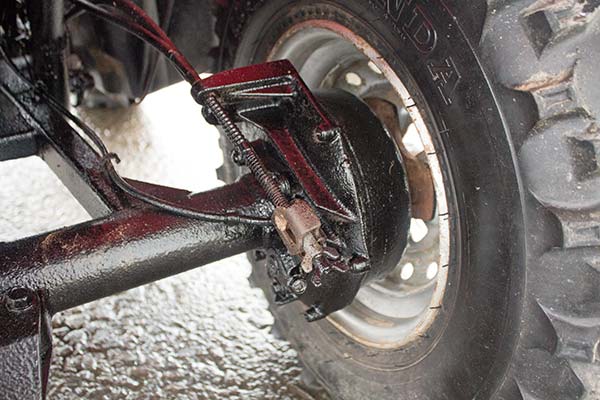

The electric shift transmission and gauges do bump the price up a bit and brings the MSRP up to $5,799. This model is identical to the last one we talked about but it has the ES transmission and you also get an electronic gauge cluster instead of just getting the dummy lights for Neutral, Check Engine, Low fuel, Water temp and Reverse while also giving you an odometer, trip meter, hour meter and maintenance minder system that helps you keep track on when Honda’s thinks you should do oil changes etc. The E comes in for Electric shift as this is the ES model and 1 means it does not have power steering. Again, TRX for ATV and 420 for engine size and T for two wheel drive. Next up is the Honda FourTrax Rancher ES and its model ID is TRX420TE1. Then the next thing is do you want a straight axle or independent rear suspension? And are you considering electric power steering or no? Transmission type, rear suspension and steering types, those are key decisions that need to be made before you can iron out exactly which model you want as some of those options aren’t available with the other. The only Honda car to utilize the DCT tech is the new NSX and it’s not exactly on the cheap side with a new NSX starting at over $150,000.īack on topic though. Oddly enough, they barely use this technology in their car lineup and that’s where all of the other manufacturers are using DCT setups. Fast forward to now and Honda has countless DCT ATV models, side by side models and motorcycles. They’ve had a couple of different styles with automatic transmissions over the years for their ATVs but shortly after introducing the DCT transmission into their motorcycle side of the business back in 2010 with the VFR1200F, they decided this tech needed to make its way offroad and brought it to their ATVs starting in 2014.

With the DCT transmission on the Rancher you can change from Automatic mode to (ESP) which means Electric Shift Program so you can manually change gears by clicking the Up and Down arrows.
HONDA ATV ENGINE BREAK IN MANUAL
The name confuses some people as they hear clutch and automatically think that it has a manual clutch but that is just the type of automatic transmission that Honda is using currently. Then you have the DCT automatic transmission, short for Dual Clutch Transmission (pictured below). A lot of people refer to this as an automatic but technically it’s not an automatic as you still have to shift gears at all times. You have the same transmission as the manual shift model but instead of shifting with your foot, you shift electronically by clicking up and down arrows on the left side of the handlebar. Then you have the ES models, short for electric shift (pictured below). Want to help Support this website? Click Here for more details. There’s no clutch, just let off the throttle and click away. It’s a semi-automatic 5 speed gearbox where you can shift up and down with the shifter by your left foot. You have your option that has been a staple in Honda’s ATVs for many decades, the manual shift option also known as foot-shift (pictured below).

One, what type of transmission do you want? Honda has three different transmission options in the Rancher lineup alone. I always like to tell people to keep a few things in the back of their head that they need to be deciding on. Definitely quite the jump.īefore we dive into explaining model by model. As the Rancher can go from being fairly affordable at $5,499 and jump all the way up to $8,699. It can be quite confusing at first because you have 8 different Ranchers but once you break down a few things and see how Honda splits them up in their categories it’s pretty easy to decipher and then figure out which one you want, which one suits your needs the best and of course which one fits into your budget. Alright guys, today we’re going to take a look at the 2021 Honda Rancher 420 model lineup and go over all of the model differences and explain what’s different between all of them.


 0 kommentar(er)
0 kommentar(er)
